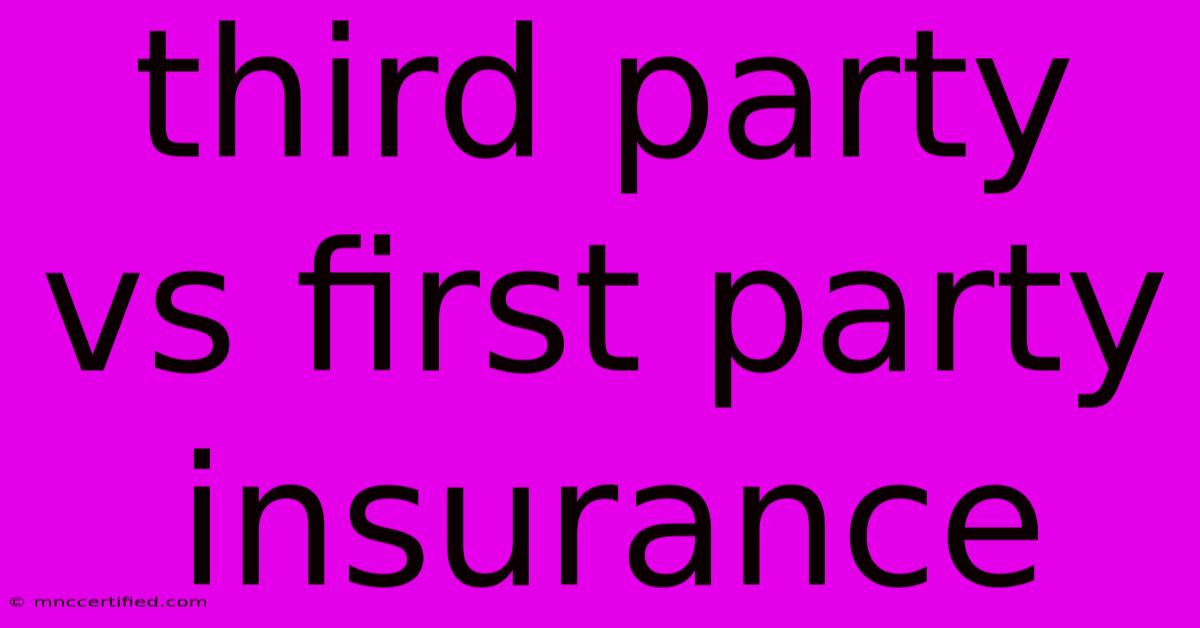Third Party Vs First Party Insurance

Table of Contents
Third-Party vs. First-Party Insurance: Which One Do You Need?
Navigating the world of insurance can feel like deciphering a foreign language, especially when you encounter terms like "third-party" and "first-party." These terms refer to different types of insurance coverage and understanding the distinction is crucial for making informed decisions about your protection.
This article will break down the differences between third-party and first-party insurance, helping you understand which coverage is right for your needs.
First-Party Insurance: Protecting Yourself
First-party insurance is all about protecting you and your own assets. This type of coverage provides financial compensation when you suffer a loss.
Here are some common examples of first-party insurance:
- Homeowners insurance: Covers damage to your home and personal belongings from events like fire, theft, or natural disasters.
- Auto insurance (collision and comprehensive): Covers damage to your vehicle caused by accidents or other incidents like vandalism or hailstorms.
- Health insurance: Pays for medical expenses incurred due to illness or injury.
Key takeaway: First-party insurance shields you from financial hardship in case of an unexpected event impacting your property or well-being.
Third-Party Insurance: Covering Others
Third-party insurance, in contrast, focuses on protecting others from your actions. It kicks in when you cause damage or injury to someone else.
Let's look at some examples of third-party insurance:
- Auto insurance (liability): Covers damages and injuries you cause to other people or their property in an accident.
- Professional liability insurance (errors & omissions): Protects professionals like doctors, lawyers, and accountants from claims arising from professional negligence.
- Product liability insurance: Covers manufacturers from claims related to faulty products causing harm to consumers.
Key takeaway: Third-party insurance acts as a safety net, helping you avoid financial ruin if your actions lead to harm or loss to others.
Understanding the Need for Both
While first-party and third-party insurance seem distinct, they often coexist. For example, a typical car insurance policy includes both first-party (collision and comprehensive) and third-party (liability) coverage.
Think of it this way:
- First-party: Protects your own assets and well-being.
- Third-party: Protects others from your actions.
By having both types of coverage, you create a comprehensive safety net, ensuring financial protection for yourself and others in various situations.
Selecting the Right Coverage
Choosing the right insurance coverage depends on your individual circumstances and risk tolerance. Consider the following:
- Your assets: The more valuable your possessions, the more important first-party coverage becomes.
- Your lifestyle: High-risk activities or professions may require additional third-party insurance.
- Your budget: Insurance premiums vary widely, so it's crucial to find a balance between affordability and adequate coverage.
Consult with a trusted insurance agent or broker to determine the appropriate levels of first-party and third-party coverage for your specific needs.
Final Thoughts
Understanding the difference between first-party and third-party insurance is fundamental to making smart insurance decisions. Remember, first-party insurance protects you, while third-party insurance protects others from your actions. By having both, you can achieve comprehensive protection and peace of mind.

Thank you for visiting our website wich cover about Third Party Vs First Party Insurance. We hope the information provided has been useful to you. Feel free to contact us if you have any questions or need further assistance. See you next time and dont miss to bookmark.
Featured Posts
-
Social Work Liability Insurance Cost
Nov 11, 2024
-
49ers Defeat Buccaneers 23 20 Five Observations
Nov 11, 2024
-
Benson Boones Flip Fans React
Nov 11, 2024
-
Four Takeaways Celtics Comeback Win Over Bucks
Nov 11, 2024
-
Should I Buy Title Insurance On Land
Nov 11, 2024